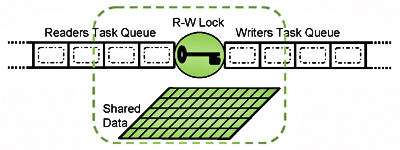Reader/Writer Lock Pattern

A reader-writer lock is a lock which will allow multiple concurrent readers but only one writer. A reader-writer lock can be significantly more efficient than a standard mutex if reads on your shared memory far outnumber writes.
Reader-writer locks naturally fit together with caches, as caches are only effective if reads far outnumber writes.
Here is a general pattern for using a reader-writer lock with a cache:
- Acquire a reader lock.
- Check the cache for the value. If it exists, save the value and go to step 8.
- Upgrade the reader lock to a writer lock.
- Check the cache for the value. If it exists, save the value and go to step 7.
- Calculate the value (expensive, otherwise we wouldn’t cache it)
- Insert the value into the cache.
- Release the writer lock.
- Release the reader lock.
- Return the value.
The reason why we have to check the cache for the value again in step (4) is because of the following possibility (assume step 4 doesn’t exist):
| Thread 1 | Thread 2 |
|---|---|
| Acquire reader lock | Acquire reader lock |
| Check cache for value with key A (not found) | Check cache for value with key A (not found) |
| Upgrade to writer lock | (block) |
| Calculate value (expensive) | |
| Insert value into cache | |
| Release writer lock | |
| Release reader lock | |
| Upgrade to writer lock | |
| Calculate value (expensive) (We are paying this cost twice) | |
| Insert value into cache (We are inserting two values with the same key, which may be fatal) |
With step 4 it becomes:
| Thread 1 | Thread 2 |
|---|---|
| Acquire reader lock | Acquire reader lock |
| Check cache for value with key A (not found) | Check cache for value with key A (not found) |
| Upgrade to writer lock | (block) |
| Calculate value (expensive) | |
| Insert value into cache | |
| Release writer lock | |
| Release reader lock | |
| Upgrade to writer lock | |
| Upgrade to writer lock | |
| Check cache for value with key A (found) | |
| Release writer lock | |
| Return value | Return value |